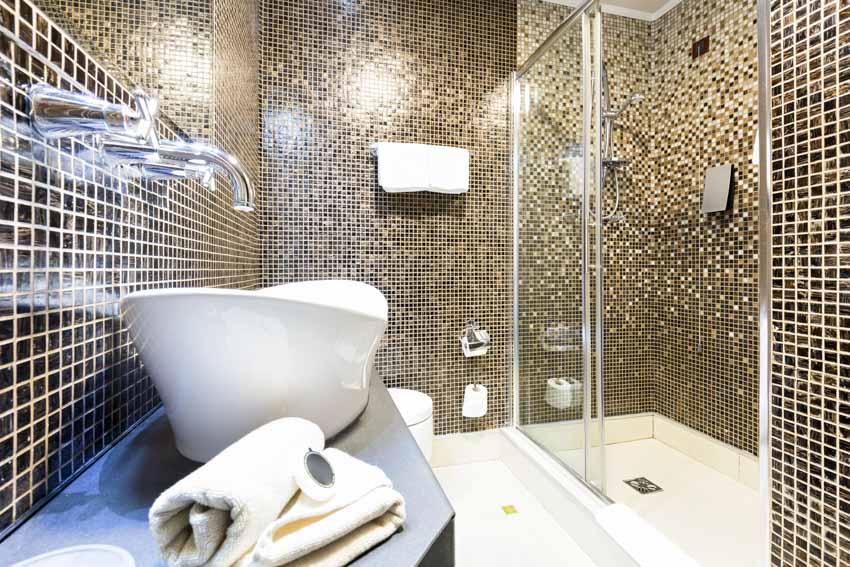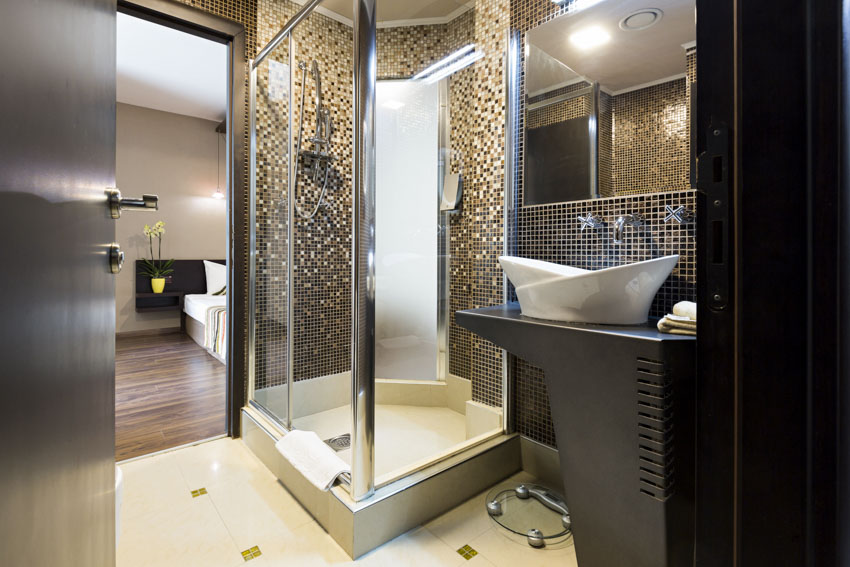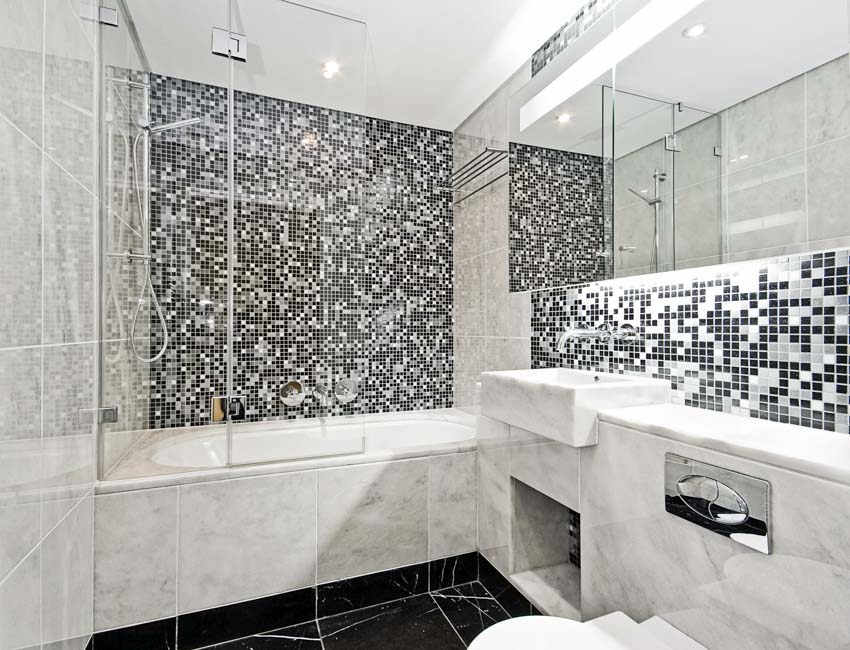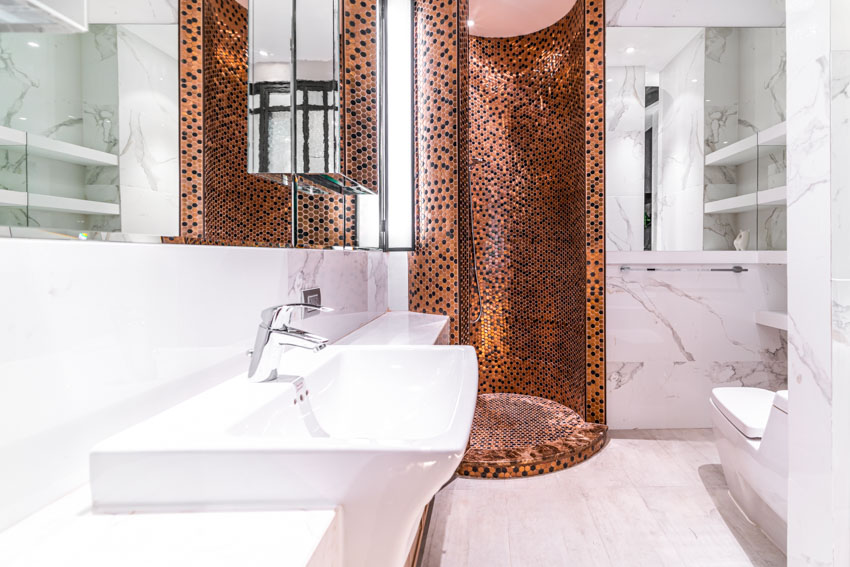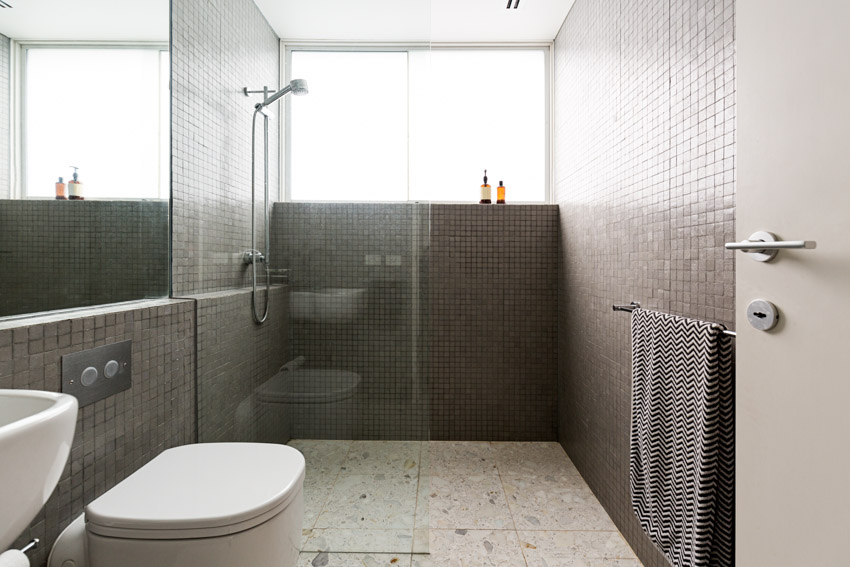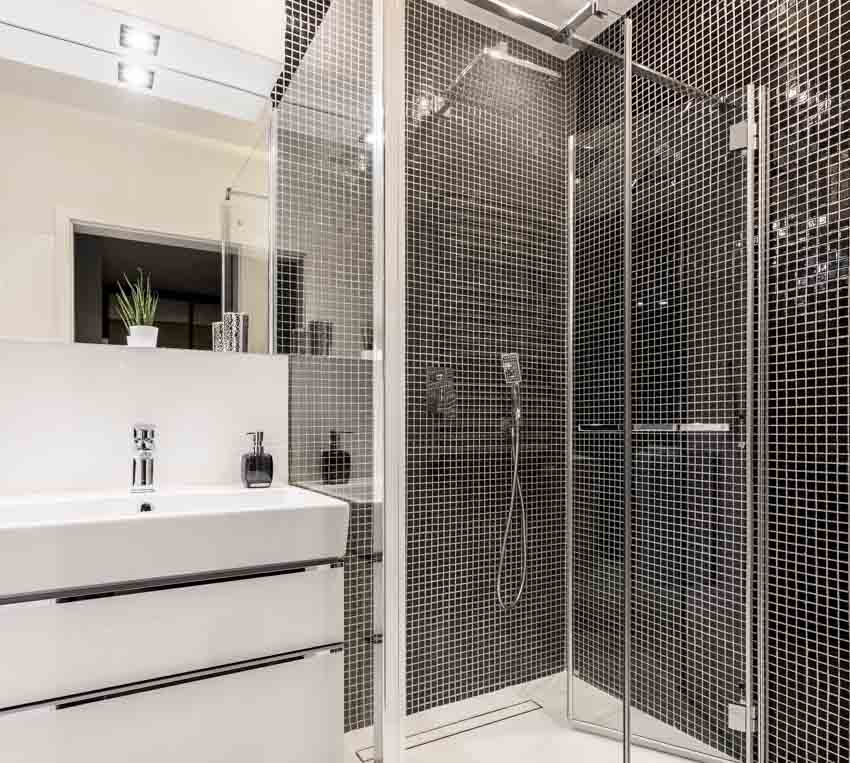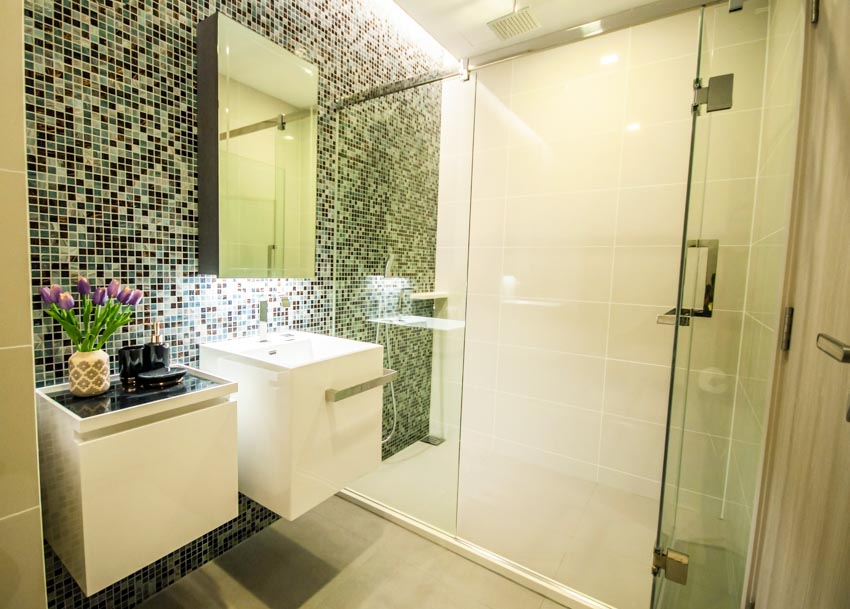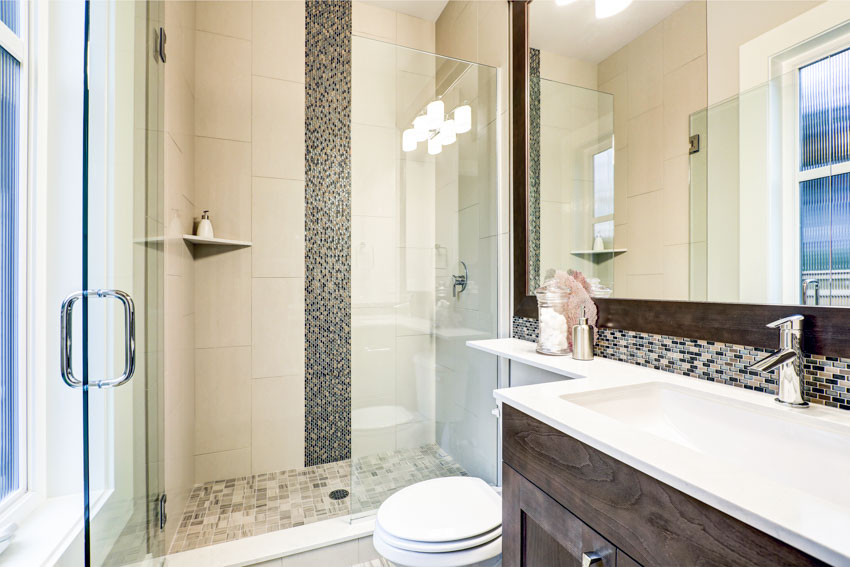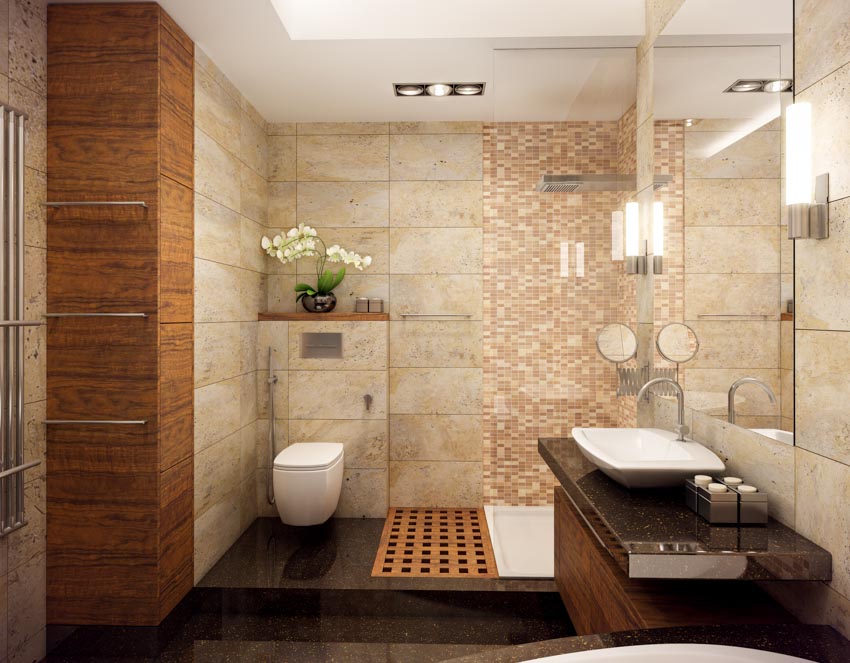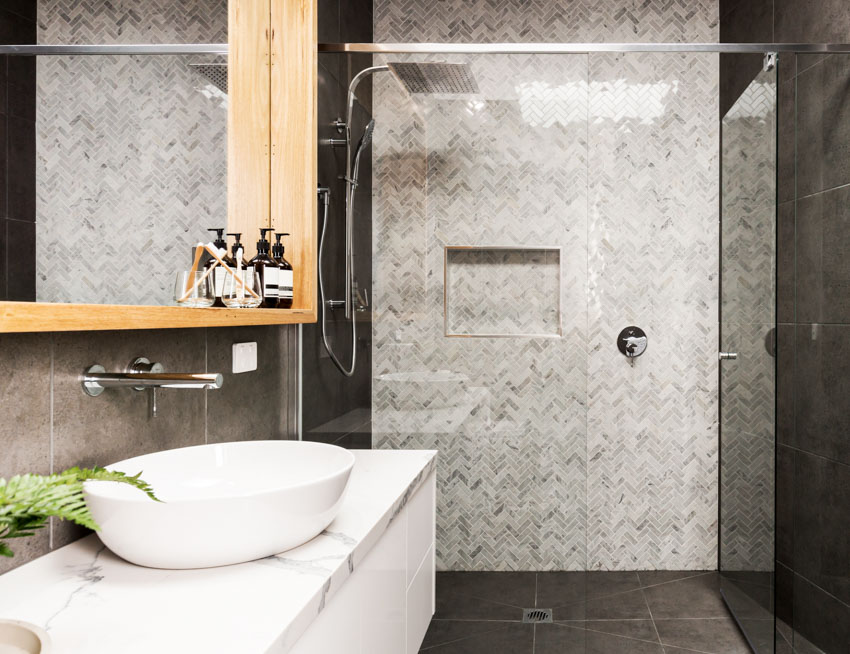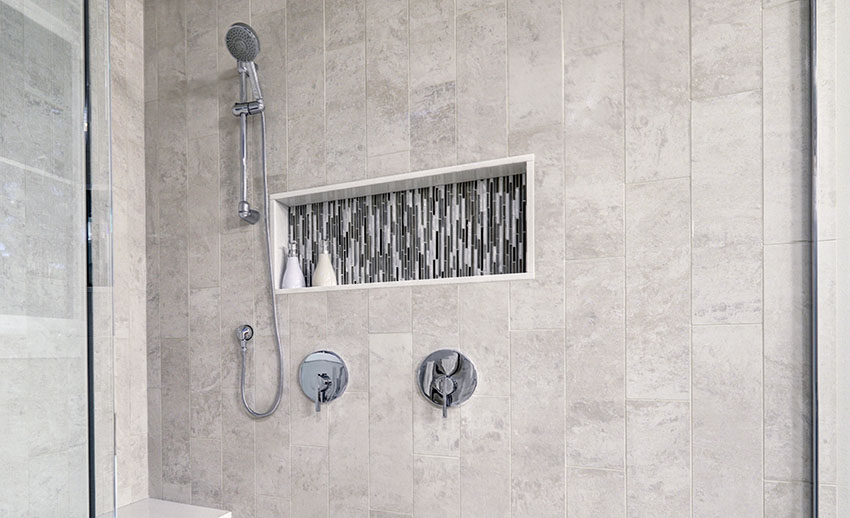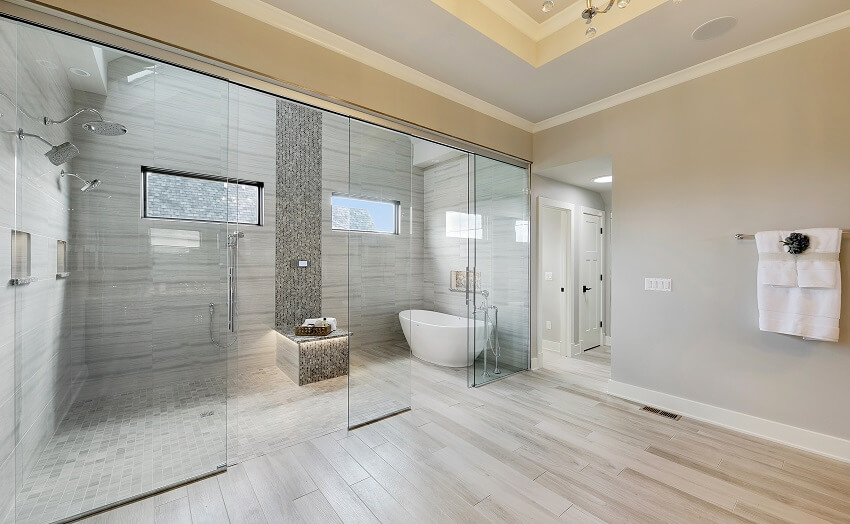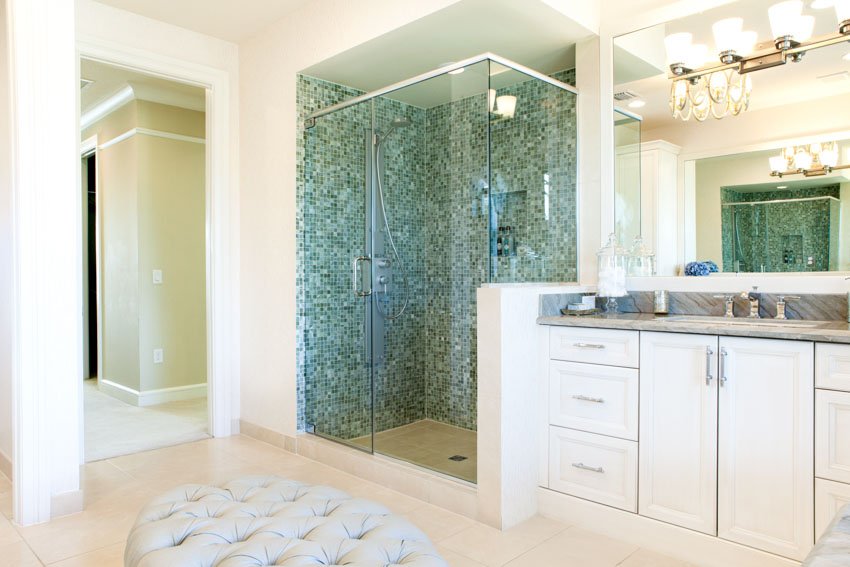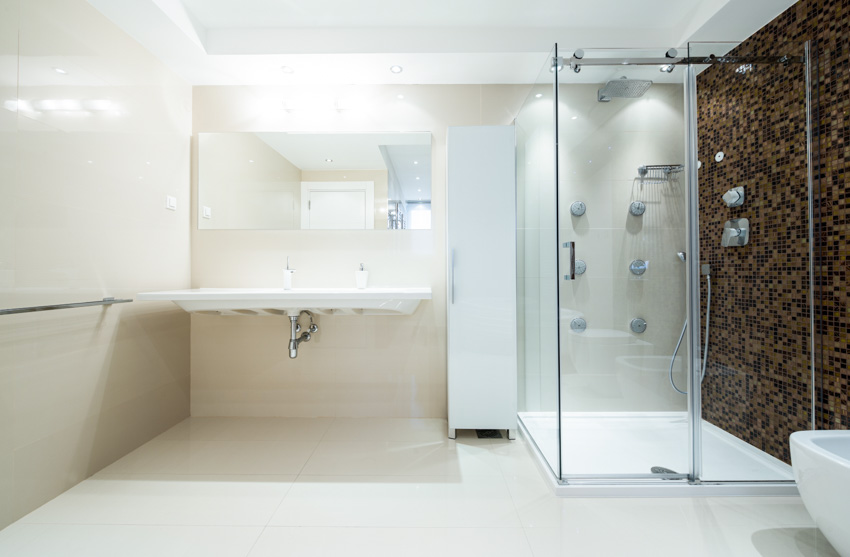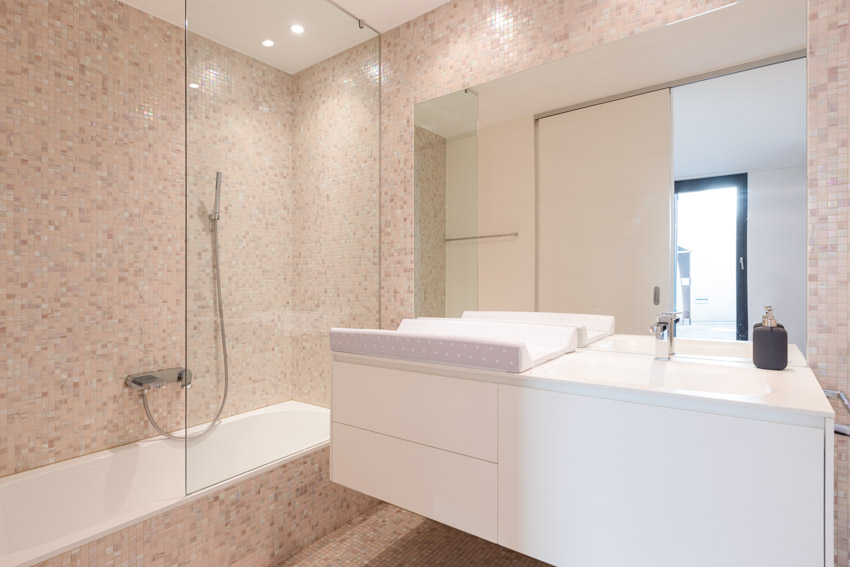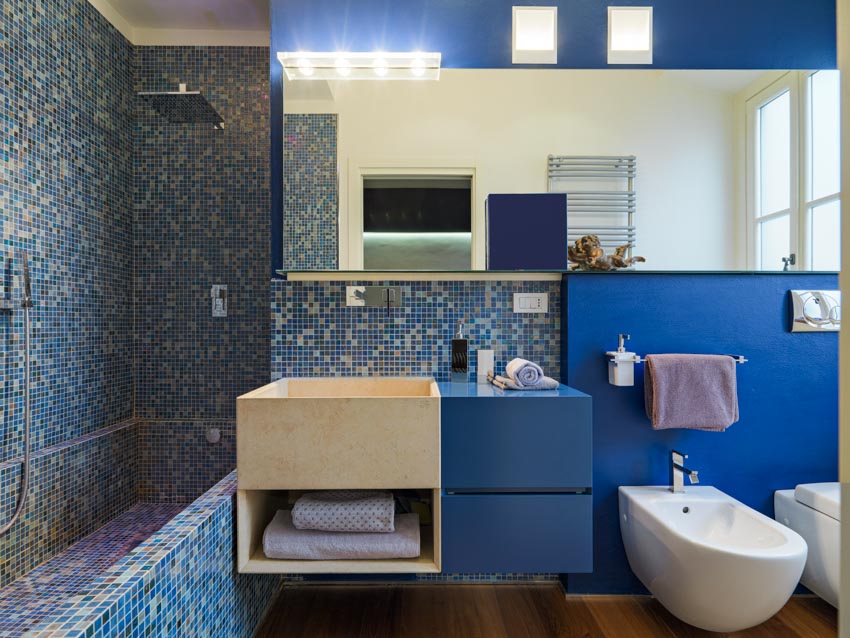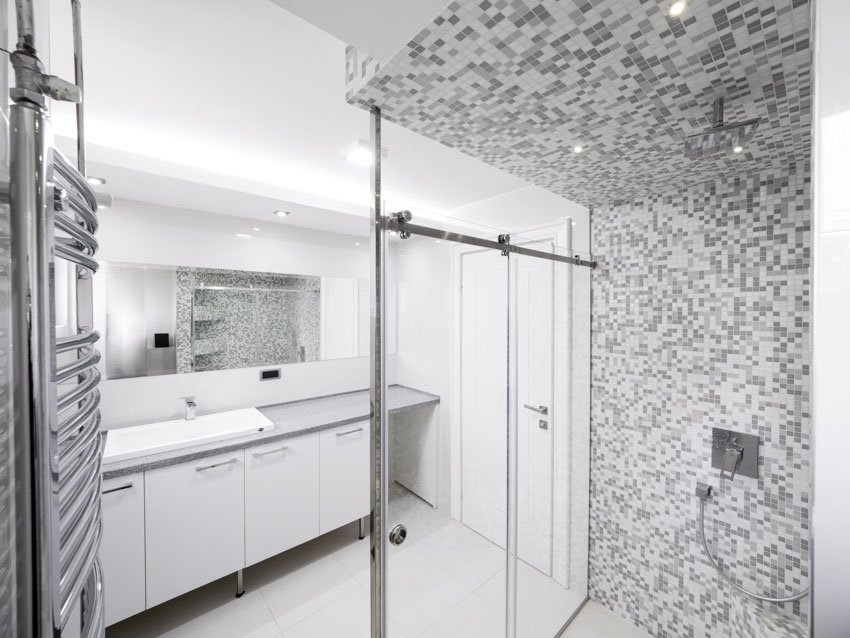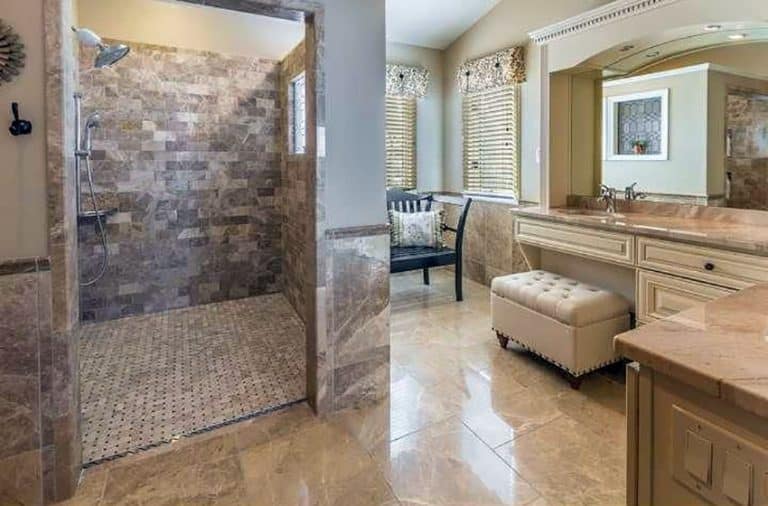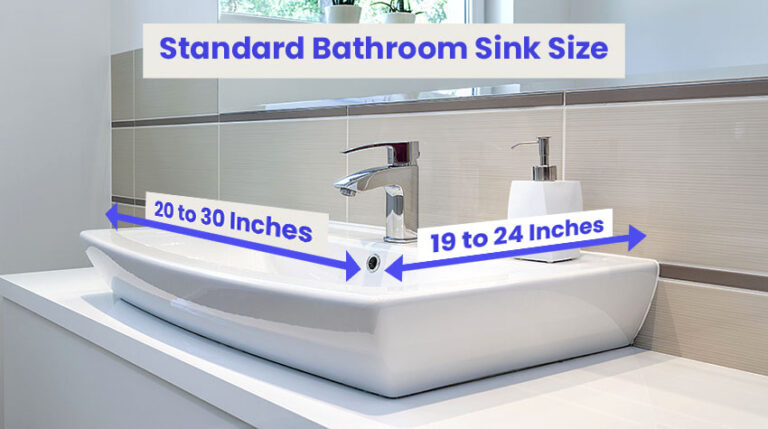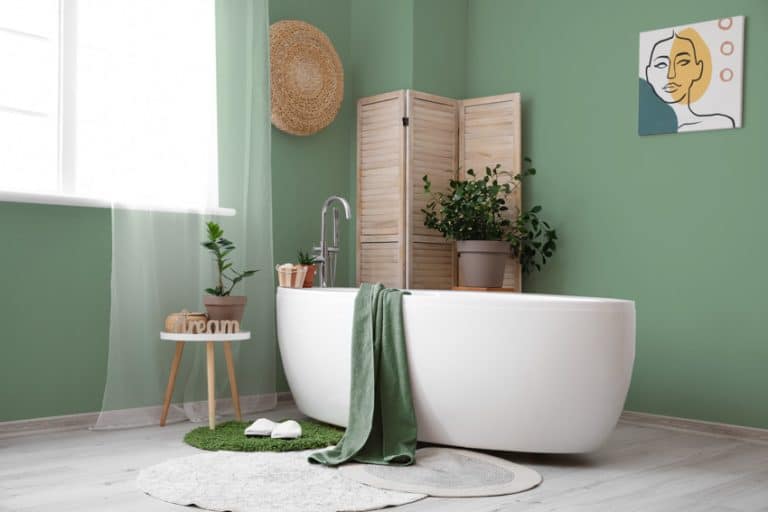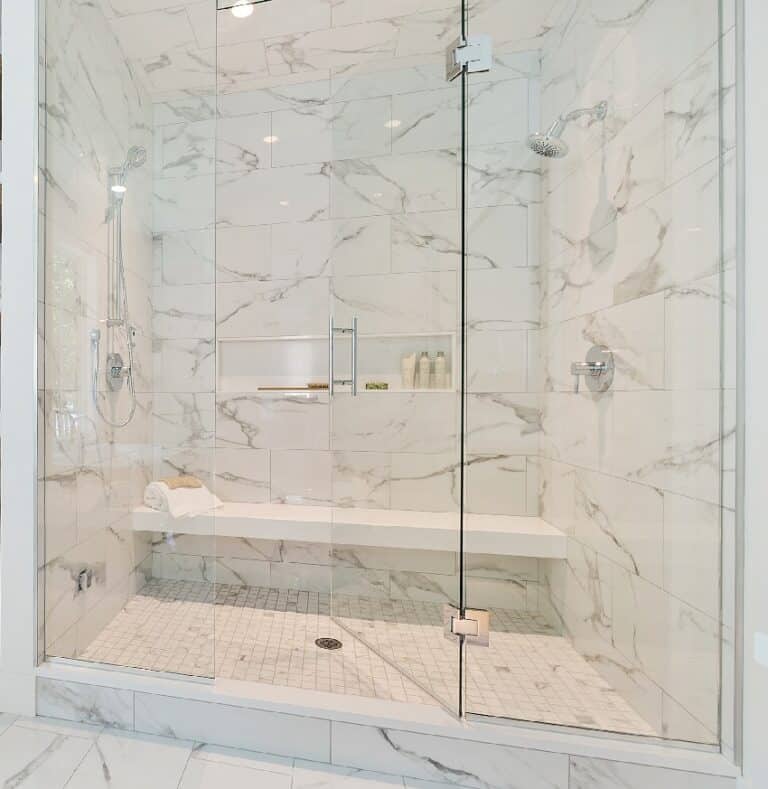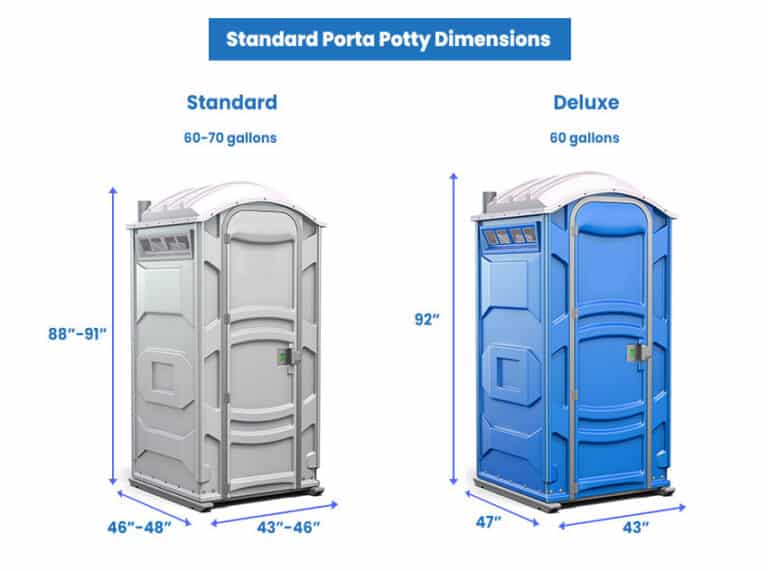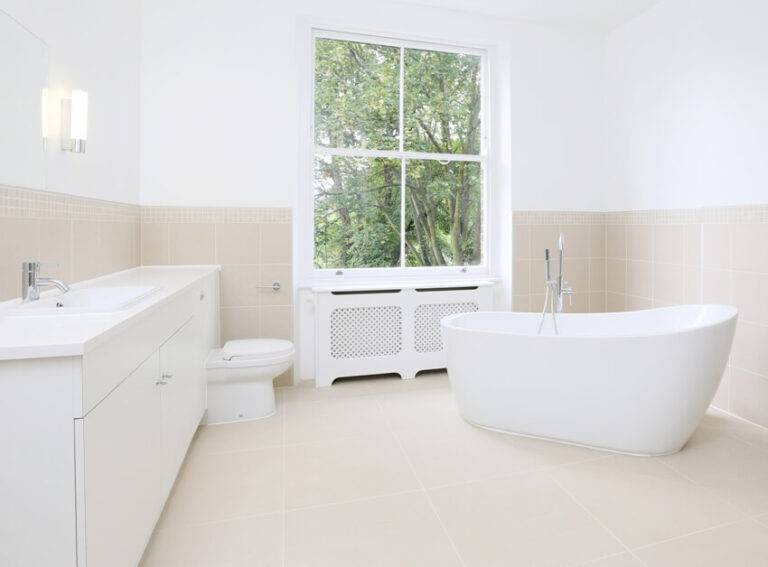Mosaic Tile Shower Wall (Ideas & Types of Materials)
A trendy and stunning way you can spruce up your bathroom is by installing a mosaic tile shower wall. The visual appeal that a mosaic style can add to a room is immense and extremely notable, whether you use it on flooring, countertops, or walls.
Mosaics started as meticulously applying tiny tile pieces individually to create a complex yet masterful pattern. These patterns are often large and intricate and installing them takes a bit of expertise and hard work. Today though, it’s different since many patterns are premade, and you won’t have to individually install the small tile pieces.
Before you go ahead and finalize your decision on mosaic tile pieces for your shower wall, make sure first that you know every tiny detail there is about them. Let’s start with the basics.
What Is a Mosaic Tile Wall?
Mosaic tiles were introduced during the rise of the Roman Empire and were used to show wealth and power in society back then. It was in the 1980s though, when the style became popular for its interesting design and quirky concept.
Despite its exhausting installation style, these tiles have become a trend that many homeowners choose to have in their houses. And since today’s mosaic tiles are more convenient and easier to install, they are even more desirable to have.
Technically, mosaic tiles can be made from a variety of materials, with their technique and styled pattern being the focal point of this type of tile. The most common, though, is the ceramic mosaic tile, which comes in the form of 2-inch small square ceramic tiles.
These squares are then put together in a fiberglass sheet and arranged in such a way that grout seams will be placed between them. While the square is the common shape of mosaic tiles, it can also have other geometric shapes like rectangles.
These mosaic sheets can either have one color or different colors altogether. Depending on the aesthetics and vibe you want to produce, you can go both ways and even create a specific pattern.
Mosaic Style Tile Applications
When it comes to the application of mosaic tiles, they have already become popular materials and styles for walls and flooring, even way back in the early 1980s. With their resistance to water and wear and tear, they’ve become a favorite for bathroom installation, where the materials are regularly exposed to moisture.
More than that, with the small mosaic tiles, the design is able to accommodate the drains and slopes of shower floors better. There’s also better slip resistance with the existence of more grout with the mosaic tiles.
And with mosaic tile types of shower walls, you have the freedom to create the pattern you want to see often. Unusual materials, from plates to small buttons, can also be added to the mix.
Types of Mosaic Shower Wall Tiles
Modern mosaic tiles come in pre-attached tiles in convenient sheets in varying colors, patterns, and styles. This means that in designing and installing your wall tiling, you have many options. You also get to have a wide selection when it comes to the materials the tiles are made from.
Some of the popular materials that are attached to mesh sheets for installation are the following:
• Ceramic
• Porcelain
• Glass
• Natural stone (Marble, Granite, Slate, & Travertine)
• Unglazed terracotta
• Metal
• Pebbles
More than just the standard installation of tiles using mortar, you also have the choice to use peel-and-stick mosaic tiles instead for more convenient installation and renovation of your walls.
To help you explore some of the options to install mosaic tiles for your walls, here are some things you need to know about these types.
Glass Tiles
Glass has always been a luxurious material featuring elegant aesthetics. This is the same way if you choose a mosaic look when entertaining glass tile shower ideas. Some glass mosaic tiles even look like crystals that will spruce your bathroom into a stunning shower space.
Glass mosaic tiles also come in a variety of styles and colors. You also have the choice among the following options:
• Opaque or Translucent
• Glossy or Frosted
• Smooth or Textured
This mosaic tile is ideal for your showers, especially since glass can withstand moisture. Glass is an excellent choice since the bathing area is regularly exposed to moisture. You can combine the glass tiles with stone blends, as well as wooden and metallic elements, depending on your preference.
Porcelain Tiles 
Another elegant choice for your walls is the porcelain mosaic tile. Similar to glass when it comes to its reaction to moisture, porcelain is another material worth considering for your bathing space. The difference though is that while glass is resistant to moisture, porcelain repels moisture instead.
Adding porcelain mosaic tiles to your walls will elevate the area in terms of aesthetics and vibe. The downside with porcelain, though, is that it’s not as durable and sturdy as glass and may even be more expensive with limited selections you can skim through.
Porcelain tiles are also very difficult to cut and work with, so you might need to hire a professional to do the job for you.
Ceramic Tiles
Ceramic tiles are the standard tiles usually used in the construction and renovation of homes because of how easy it is to work with this material (Despite needing a tile saw or a standard tile cutter).
Considering it’s soft to cut, creating shapes and curves in ceramic tiles is not just possible but easy to accomplish, too, so you can cut and design them however you want.
Compared to the first two materials discussed, ceramic tiles absorb moisture readily and easily, making them a mismatch for your walls.
This is the reason why it is necessary to glaze the top of the surface and properly seal it to prevent moisture absorption. With ceramic’s permeability, this is a necessity.
Mosaic Bathroom Wall Ideas
More than just the different types of mosaic tiles based on the materials they are made from, you can also take into account the styles, designs, and ideas you can apply when using mosaic tiles.
This is actually one of the most fun and exciting parts of this project since you get to be as creative as you want to be. You can match different materials and colors, as well as create or follow a creative pattern that can add value to your bathroom walls.
To have a place to start, if you don’t have a pattern picked out yet, you can check these ideas.
Waterfall Tiles for the Shower
When you come across waterfall mosaic tiles, you’re actually considering a striking aesthetic that can spruce up your shower.
This particular style creates visual flow and dynamics, making it an ideal choice for areas and rooms that need some movement. So, if your bathroom shower area feels too monotonous and boring, this change in your shower walls may be considered.
Waterfall mosaic tile shower walls can also brighten the area if you choose a combination of beige and white colors and pair them with something metallic, like bronze.
When they are paired with stone and glass, they offer a subtle vibe that will play well with those in need of modern bathroom design ideas.
Wall Accents for Shower Tiles
If you want to build a focus wall in your shower and create a masterpiece, you can make a mosaic tile accent wall. In this case, you have the freedom to design the wall however you want and the mosaic tiles will make it easy and convenient for you to create those designs.
One thing you can consider to make your shower pop is to go bold with your shower walls while remaining simple and plain for the flooring.
A classic tile design of mosaic tiles is enough to make the shower walls stand out. If you want something different, try forming unique graphics and fun patterns instead. See more pictures of mosaic tile shower floors here.
Herringbone Patterned Tiles
Herringbone is a popular dynamic pattern and style that remains popular among homeowners and construction experts. The timeless pattern makes use of rectangular tiles that are arranged in a way where a fish or “herring” pattern is created.
You can use herringbone mosaic tiles for your shower walls if you’re looking for something different and unique. While technically not new, the pattern may add something fresh-looking to your shower area.
If you want the dynamic look of herringbone mosaic tiles but want them more subtle on your shower walls, choose neutral colors like white, beige, and cream. If you want something loud and eye-catching, go for bold colors like red and black.
Adding Mosaic Patterns to the Shower Niche
A shower niche is a hollowed storage space (usually rectangular) nestled on the wall like a cubbyhole that’s often used to keep bathroom items organized or add decorative elements to the shower.
If you have a niche in your shower and you’re planning on renovating the walls with mosaic tiles, make sure to consider what you will do with the niche. And there are two options you can consider.
You can either renovate it similarly to the rest of the walls, with the mosaic tiles designing the niche, or you can make it stand out by choosing a different tile for it, adding more texture to the wall, not just because of its hollowed look.
Pros And Cons of Mosaic Tiling in the Shower Area
Having a mosaic tile shower wall can have both positive and negative effects on your home. Understanding the possibility of these two is the best way to determine if mosaic tile shower walls are the ideal option for your renovation project.
Pros
The different advantages you can get by choosing mosaic tiles for your shower walls are what make them worth considering and installing. Here are the notable benefits you will surely enjoy with mosaic tiles.
Aesthetically Pleasing: Mosaic tiles are aesthetically superior and this has been proven way back in history, especially since they are even used as a symbol of wealth and station in the Roman Empire.
The beauty of these patterned tiles has graced temples and mansions. And today, they can easily transform your design from plain and simple to an elegant luxury shower. The intricacy of the designs can only be limited by your imagination.
Waterproof, Dirt-resistant, & Wear-resistant: Mosaic tiles are popular for having strong resistance to daily wear and tear, as well as to other harmful elements like moisture, dirt, and stain.
This makes them ideal to be installed in the shower area where exposure to moisture is a regular occurrence. They won’t fall off the wall and turn yellow when exposed to too much water.
High Durability: Highly durable, these can withstand daily wear and severe damage. They can withstand an average household’s demands for quite a long time. This means that they can be a great investment since they will not only last for a long time but also look stunning for years to come.
Colorful & Highly Decorative: The great thing about mosaics is that they are flexible and highly customizable so you can use the patterns you prefer when you install them. You can even combine colors and shapes if that’s what you prefer, as well as materials if needed.
Easy to Clean & Maintain: These are also easy to clean since they have smooth surfaces. With this glossy surface, dirt doesn’t get stuck in the crevices. This is the same way when it comes to mold and mildew.
With these low maintenance shower walls, you just need to wipe the surface with warm and soapy water to clean them. Very little is required when it comes to the maintenance of these mosaics.
Environmentally Friendly: These are considered green products and environmentally friendly because most of them are made from natural materials and are individually handmade rather than artificially produced through a process that can be harmful to the environment.
Cons
Besides the advantages you are sure to enjoy when using this flooring for your bathroom walls, there are always drawbacks you need to know about. Check out these disadvantages of using smaller tile pieces as shower walls.
Varied & Challenging Installation: Its installation is widely varied in the sense that they can be very easy if you won’t be dealing with intricate patterns, but they can also be challenging and complex if you will have to work with the small tiles individually and even in different shapes and colors just to successfully produce the pattern you’re envisioning.
Can Be Expensive: While it will rely on the materials they are made of, such tiling can come expensive, especially for pre-arranged ones on their respective mesh sheets. The installation fee is also not cheap, especially if you’re making a professional do some intricate images and patterns.
Can Be Slippery: With a glossy and smooth surface, it’s not surprising that these can be slippery underfoot. With the shower walls, though, you have less to worry about.
Possible Scratches & Damages: This tiling is strong and durable, but it is not a hundred percent resistant to damage. In fact, they are prone to scratches (especially if you have children and pets at home) and may require replacement if too much damage has been done to them.
Mosaic Installation for the Shower
Installing mosaics is easier than standard tile pieces since you don’t need to handle special equipment just to cut them like with regular ones. Cutting mesh sheets of mosaics is way easier.
Here are simple steps to install such type of tiling.
• Step 1: Prepare the surface of the shower walls. Before installing the mesh sheet, make sure that the surface is smooth and flat, as well as clean and dry.
• Step 2: Plan the layout of sheets on the walls. Arrange the tile sheets in the positions you want them to before installing them.
• Step 3: Apply a thin-set mortar to the cement board. Rather than using adhesives, use mortar instead for the installation.
• Step 4: Lay the tile pieces on the surface. Start at the very center of the walls, going outwards.
• Step 5: Install trim or accent tiles. Use baseboard tiling, bullnose liners, or cove tile pieces.
• Step 6: Grout the tiles. Make sure to wait for the mortar to set before grouting and then cleaning the surface.
Do You Need To Seal Mosaics in the Shower?
Yes, it is highly recommended that you seal it if you choose to install them on your shower walls. Depending on the material they are made of, those with highly porous surfaces like ceramics and natural stones will need to be sealed before and after the installation. This will prevent staining after a long time.
Other materials, though, like porcelain and glass, only need to be sealed after the installation, particularly the grout lines, since they are naturally porous.
Sealing them will protect the underlayment from moisture and water damage. This is very important for this flooring type installed in shower areas since they are regularly exposed to moisture.
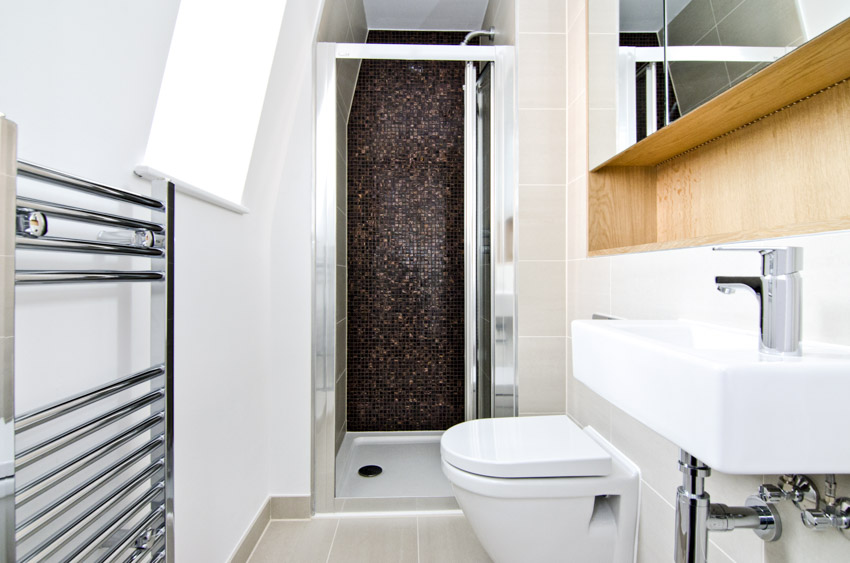
Do Mosaic-Tiles Need Grout?
Yes, when installing this type of tiling, especially in shower areas, you will need to grout them to protect them against moisture and dirt.
Since they tend to be uneven with the small tiles involved in the installation, grouting them will level them and produce an even finish that will add value to the aesthetics of your shower walls.
When grouting your floors, you can apply the sealer using a roller or brush. Make sure that you cover the entire surface and wipe away excess as you brush along all parts. Allow the surface to dry completely and penetrate the surface.
What Is the Best Grout for Smaller Tiles for the Shower?
These need grouting to further protect the material, especially if you’re planning to install them on your walls and be exposed daily to moisture.
This is why it’s necessary to carefully choose your grout, especially since the mosaics need grout that won’t damage the surface. Make sure you also take into account the tile thickness, the gaps between them, and the area covered by the entire mosaics.
If you install them in areas always exposed to moisture, like in the walk-in showers, you will need thinset as a bonding agent.
For the grout, epoxy grout is highly recommended to provide a more stable foundation that’s also resistant to cracking and staining brought by weather and temperature changes.
Since regular sanded grout can be abrasive to mosaics, using unsanded grout’s a good idea. This is especially true for glass mosaics that are more prone to scratches. Sanded grout should also never be used for tile joints smaller than 1/8 of an inch.
Best Way to Clean Mosaics
These come in a variety of materials, shapes, colors, and styles. Most of the time, you will need to take these factors into account when cleaning the flooring in your walk-in showers.
To give you a general idea of what to do when cleaning tiled flooring, here are simple steps to follow.
Step 1: Create your cleaning solution
There are different types of cleaning solutions you can use on your tiling. Here are some solutions you can mix at home, including the following:
• General Cleaning: Household detergent solution (1 tablespoon detergent + 2 cups of water)
• For Heavy Soap Scum & Water Marks: TSP cleaner (1 tablespoon Trisodium Phosphate cleaner + ½ gallon of hot water)
• For Grout: Bleach solution (¾ cup of bleach + 1 gallon of water)
Step 2: Spray the solutions onto the tile surface
Spray the respective solutions onto the surface and let them rest on the surface to fully settle on the tiles. Pay special attention to areas with watermarks and soap scum and let its respective solution soak for 5 minutes before rinsing thoroughly with clear water. Get a soft rag and wipe the surface dry.
Step 3: Start cleaning the grout
Get a soft-bristled brush, dip it in the bleach solution, and start scrubbing the grout clean until you see it brighten.
Step 4: Rinse the tile pieces completely: Thoroughly rinse the pieces using clear water after all the scrubbing and wiping. Make sure that you cover all areas. Get a soft towel and wipe the surface completely dry to avoid water spotting on the surface of the tiling.
See more related content in our article about laminate shower walls on this page.

